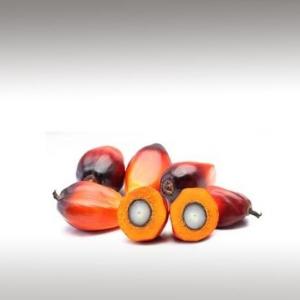
PALM OIL (ELAEIS GUINEENSIS, ATTALEA MARIPA, ELAEIS OLEIFERA) - BASE OILS

BASE / GENERAL DATA
Information submited: January 31, 2015 Modified: May 9, 2018 By: OperaDreamhouse
Palm oil is an edible vegetable oil derived from the Mesocarp (Reddish pulp) of the fruit of the oil palms, primarily the African oil palm Elaeis guineensis, and to a lesser extent from the American oil Palm (Elaeis Oleifera) and the Maripa Palm (Attalea Maripa).
Human use of oil Palms may date as far back as 5,000 years. In the late 1800s, archaeologists discovered a substance that they concluded was originally palm oil in a tomb at Abydos dating back to 3,000 BCE. It is thought that Arab traders brought the oil Palm to Egypt.
Indonesia is the largest producer of Palm oil, Malaysia is the world's second largest producer of Palm oil.
The Palm oil industry has had both positive and negative impacts on workers, indigenous peoples and residents of Palm oil - producing communities.
Palm oil cultivation has been criticized for impacts on the natural environment, including deforestation, loss of natural habitats, which has threatened critically endangered species such as the Orangutan and Sumatran Tiger, and increased greenhouse gas emissions.
Environmental groups such as Greenpeace and Friends of the Earth oppose the use of Palm oil biofuels, claiming that the deforestation caused by oil Palm plantations is more damaging for the climate than the benefits gained by switching to biofuel and utilizing the Palms as carbon sinks.
Elaeis Guineensis is a species of palm commonly called African Oil Palm or Macaw-fat. It is the principal source of Palm oil. It is native to west and southwest Africa, specifically the area between Angola and the Gambia. The species is also now naturalised in Madagascar, Sri Lanka, Malaysia, Sumatra, Central America, the West Indies and several islands in the Indian and Pacific Oceans.
Mature palms are single-stemmed and grow to 20 m tall. The leaves are pinnate and reach between 3 - 5 m long. A young palm produces about 30 leaves a year. The Palm fruit takes five to six months to mature from pollination to maturity. It is reddish, about the size of a large Plum, and grows in large bunches. Each fruit is made up of anoily, fleshy outer layer (the pericarp), with a single seed (the Palm kernel), also rich in oil. When ripe, each bunch of fruit weighs 40 - 50 kg.
Elaeis Oleifera is a species of Palm commonly called the American Oil Palm. It is native to South and Central America from Honduras to northern Brazil.
Unlike its relative Elaeis Guineensis, the African Oil Palm, it is rarely planted commercially to produce Palm oil, but hybrids between the two species are, mainly in efforts to provide disease resistance and to increase the proportion of unsaturatedfatty acids in the oil.
Attalea Maripa, commonly called Maripa Palm is a palm native to tropical South America and Trinidad and Tobago. It grows up 35 m tall and can have leaves or fronds 10 - 12 m long. This plant has a yellow edible fruit which is oblong ovoid and cream. An edible oil can be extracted from the pulp of the fruit.
It is present in Colombia, Venezuela, Guyana, Suriname, French Guiana, Ecuador, Peru and Brazil. It is found in lowland forests and disturbed areas, on soils that are not usually flooded.
Carbonised Attalea Maripa seeds have been found in archaeological sites in Colombia dating back to 9000 BP. The Huaorani of Amazonian Ecuador use the mesocarps for food.
Chemical structure:
Palm oil like all fats, is composed of fatty acids, esterified with glycerol. Palm oil has an especially high concentration of saturated fat, specifically, of the 16-carbon saturated fatty acid palmitic acid, to which it gives its name. Monounsaturated oleic acid is also a major constituent of Palm oil. Unrefined Palm oil is a large natural source of tocotrienol, part of the Vitamin E family.
Palm oil is naturally reddish in color because of a high beta-carotene content. Like Tomatoes, Carrots and many other fruits and vegetables but unlike most oils, Palm oil naturally contains the nutrients alpha-carotene, beta-carotene and lycopene. Palm oil contains other carotenes including tocopherols and tocotrienols (members of the Vitamin E family), CoQ10, phytosterols, and glycolipids.
Human use of oil Palms may date as far back as 5,000 years. In the late 1800s, archaeologists discovered a substance that they concluded was originally palm oil in a tomb at Abydos dating back to 3,000 BCE. It is thought that Arab traders brought the oil Palm to Egypt.
Indonesia is the largest producer of Palm oil, Malaysia is the world's second largest producer of Palm oil.
The Palm oil industry has had both positive and negative impacts on workers, indigenous peoples and residents of Palm oil - producing communities.
Palm oil cultivation has been criticized for impacts on the natural environment, including deforestation, loss of natural habitats, which has threatened critically endangered species such as the Orangutan and Sumatran Tiger, and increased greenhouse gas emissions.
Environmental groups such as Greenpeace and Friends of the Earth oppose the use of Palm oil biofuels, claiming that the deforestation caused by oil Palm plantations is more damaging for the climate than the benefits gained by switching to biofuel and utilizing the Palms as carbon sinks.
Elaeis Guineensis is a species of palm commonly called African Oil Palm or Macaw-fat. It is the principal source of Palm oil. It is native to west and southwest Africa, specifically the area between Angola and the Gambia. The species is also now naturalised in Madagascar, Sri Lanka, Malaysia, Sumatra, Central America, the West Indies and several islands in the Indian and Pacific Oceans.
Mature palms are single-stemmed and grow to 20 m tall. The leaves are pinnate and reach between 3 - 5 m long. A young palm produces about 30 leaves a year. The Palm fruit takes five to six months to mature from pollination to maturity. It is reddish, about the size of a large Plum, and grows in large bunches. Each fruit is made up of anoily, fleshy outer layer (the pericarp), with a single seed (the Palm kernel), also rich in oil. When ripe, each bunch of fruit weighs 40 - 50 kg.
Elaeis Oleifera is a species of Palm commonly called the American Oil Palm. It is native to South and Central America from Honduras to northern Brazil.
Unlike its relative Elaeis Guineensis, the African Oil Palm, it is rarely planted commercially to produce Palm oil, but hybrids between the two species are, mainly in efforts to provide disease resistance and to increase the proportion of unsaturatedfatty acids in the oil.
Attalea Maripa, commonly called Maripa Palm is a palm native to tropical South America and Trinidad and Tobago. It grows up 35 m tall and can have leaves or fronds 10 - 12 m long. This plant has a yellow edible fruit which is oblong ovoid and cream. An edible oil can be extracted from the pulp of the fruit.
It is present in Colombia, Venezuela, Guyana, Suriname, French Guiana, Ecuador, Peru and Brazil. It is found in lowland forests and disturbed areas, on soils that are not usually flooded.
Carbonised Attalea Maripa seeds have been found in archaeological sites in Colombia dating back to 9000 BP. The Huaorani of Amazonian Ecuador use the mesocarps for food.
Chemical structure:
Palm oil like all fats, is composed of fatty acids, esterified with glycerol. Palm oil has an especially high concentration of saturated fat, specifically, of the 16-carbon saturated fatty acid palmitic acid, to which it gives its name. Monounsaturated oleic acid is also a major constituent of Palm oil. Unrefined Palm oil is a large natural source of tocotrienol, part of the Vitamin E family.
Palm oil is naturally reddish in color because of a high beta-carotene content. Like Tomatoes, Carrots and many other fruits and vegetables but unlike most oils, Palm oil naturally contains the nutrients alpha-carotene, beta-carotene and lycopene. Palm oil contains other carotenes including tocopherols and tocotrienols (members of the Vitamin E family), CoQ10, phytosterols, and glycolipids.

SPIRITUAL PRACTISES DATA

MEDICINE / HEALTH DATA

BEAUTY / COSMETICS DATA

FOOD / COOKING DATA
COMMENTS
No comments.


